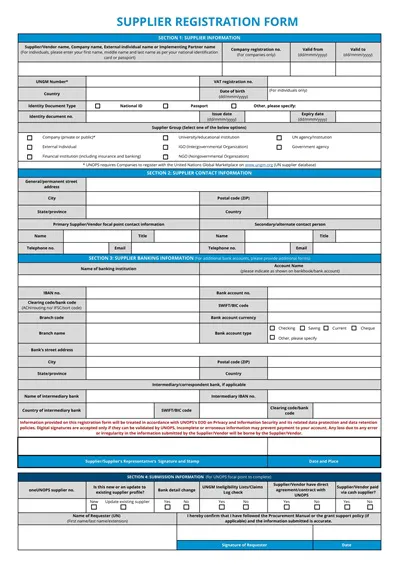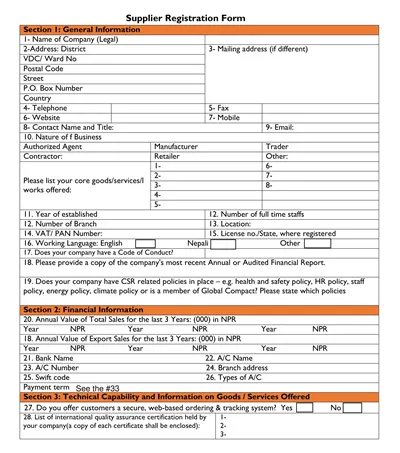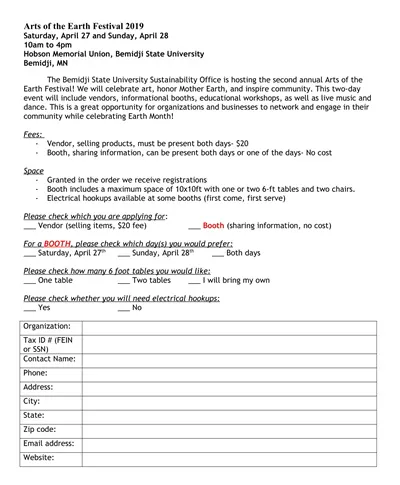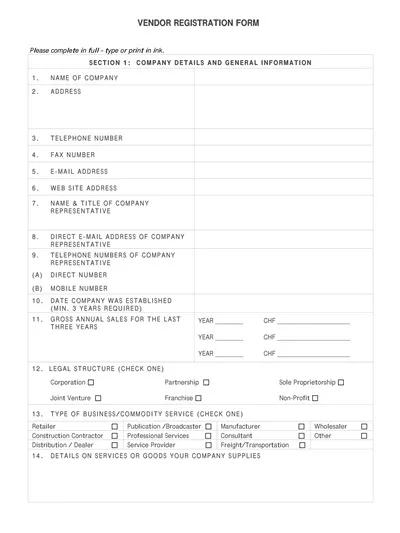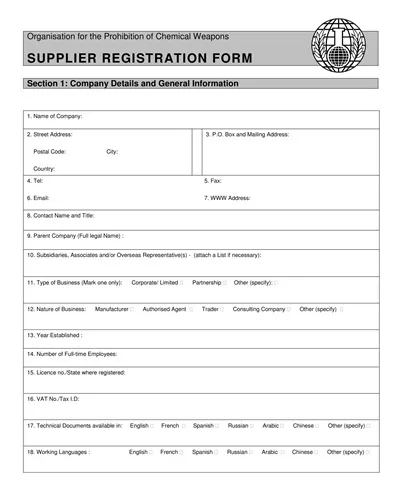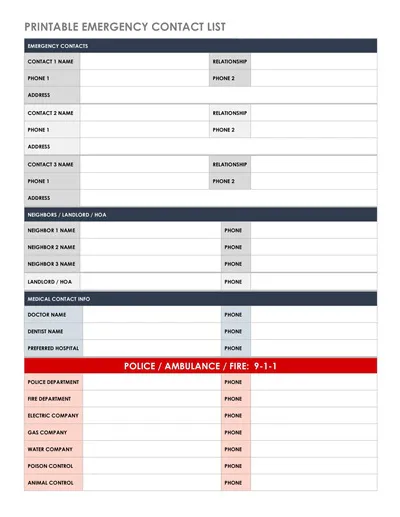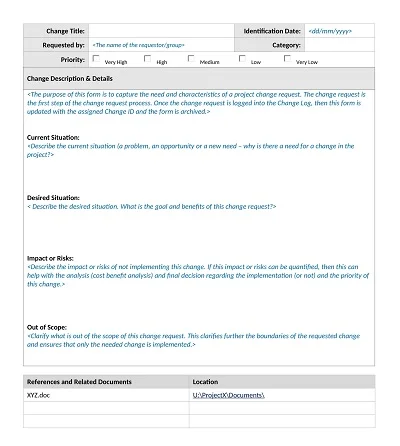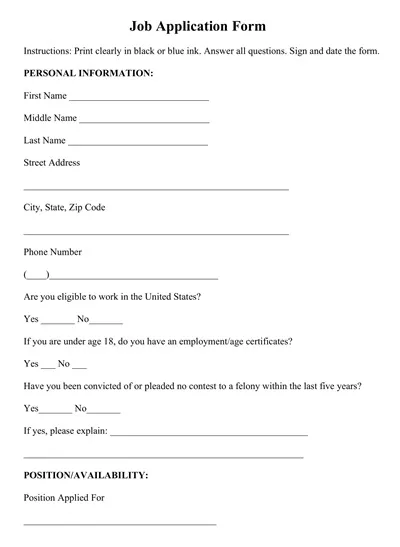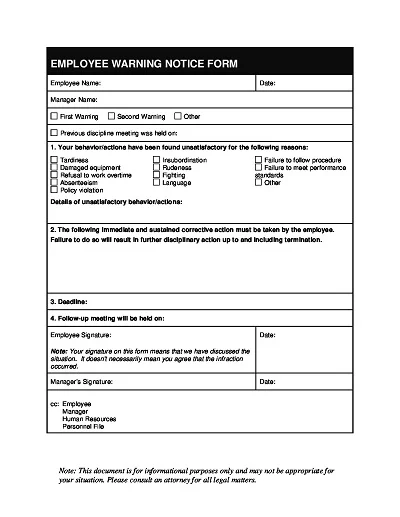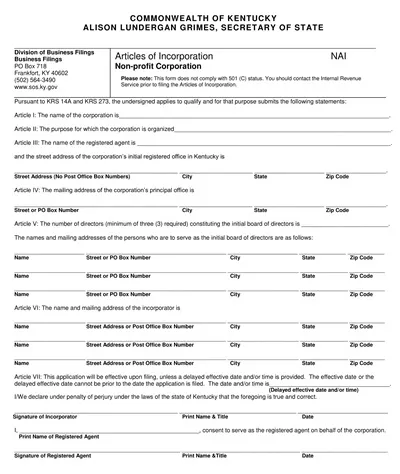A Supplier Registration Form Template is a general template containing the necessary fields in which an organization fills out its essential details from suppliers or vendors. This form is usually made with entries for the supplier’s company name and address, the supplier’s telephone and fax numbers, the supplier’s tax identification numbers, and bank details.
Further, it might include inquiries into the supplier’s products/services provided, accreditation, and recommendations. The primary focus of this template is to eliminate much manual work involved when onboarding new suppliers and to harmonize the types of data captured, thus facilitating supplier evaluations and, in turn, vending. This type of form plays the role of a starting point for creating a business partnership and guaranteeing compliance and order.
Download Free Supplier Registration Form Templates
What is a Supplier Registration Form?
A Supplier Registration Form is essential for businesses to fulfill the first engagement stage with potential new suppliers. In that regard, it helps the company obtain complete information about a business that wants to partner with it.
The information in this form may be called for, including the phone number and physical address, business permits and IDs, tax ID numbers, and reference banker/bank statements. When such data is compiled, organizations can determine the credibility rating, efficiency, and readiness of the supplier to deliver the goods or services deal. The form helps speed up the suppliers’ examination and choice and contributes to keeping records of suitable vendors for future use.
Components of a Supplier Registration Form
The sections of a Supplier Registration Form are developed below with the goal of obtaining all of the required details in a synchronous way. Here are the primary components typically included:
- Supplier Information: This segment asks for everyday information about the supplier, the name, physical location, and the contact person of the supplier. This might also contain fields for phone numbers, e-mail addresses, URLs, or websites.
- Business Details: In this section of the form, the identification of the supplier’s enterprise form is required, including a legal form of the enterprise (individual entrepreneur, partnership, corporations, etc.), years of operation, and registration numbers, if any.
- Tax and Financial Information: Suppliers must present their tax identification number and other details that may facilitate the transactions. This section makes a check to confirm that the legal and fiscal requisites for both parties have been fulfilled.
- Product or Service Offerings: Amidst the defined selling strategies, suppliers introduce the products offered by mentioning essential qualifications of the service or product and sometimes catalogs/brochures.
- Certifications and Standards: If necessary, the suppliers might be asked to present some evidence of conformity to certain requirements or standards. It confirms the authorization and authenticity of the supplier.
- References: The form may include questions asking the clients to provide references to determine reliability. Such information is useful in assessing the supplier’s accreditation and previous performance.
- Additional Information: This section is voluntary; any other information or document required to assess the suppliers may be included.
Every one of these components assists various companies in performing a detailed evaluation of prospective suppliers to meet the organizations’ requirements for operating efficiently and effectively with the right suppliers.
Benefits of Using Supplier Registration Forms
Supplier registration forms in the procurement process have provided several advantages. This helps gather effective information and ensures an improved structure for supplier management solutions. Here are some of the benefits of using supplier registration forms:
1. Efficient Employee Induction
Supplier registration forms make work easier when engaging new suppliers because many details a supplier needs to provide are already determined in advance. This consistency helps reduce the time to evaluate the documentation received from the various suppliers, as everyone submits what is required.
2. Enhanced Supplier Evaluation
Through these forms, organizations obtain wide and detailed information necessary to evaluate the supplier’s competence, dependability, and conformity. This rigorous screening assists in choosing the right and most appropriate suppliers for strategic alliances.
3. Improved Compliance and Risk Management
Standardized tax, legal, and certification information collection is crucial in managing compliance risks. The supplier registration forms help to check legal compliance and reduce risks of errors resulting from the suppliers’ non-compliance.
4. Efficient Record Keeping
These forms ensure that supplier information is stored systematically to ensure the required data can be accessed and used. Documentation is crucial for audits and evaluations and long-term business relationships.
5. An RMR that is improved
After the data has been collected and analyzed, organizations, with the help of data, can develop improved relations with their suppliers because of their knowledge regarding the capability and requirements of the supplier. The knowledge greatly helps get around the actions, including communicating, bargaining, and teaming.
6. Cost and Time Savings
Using digital forms in the supplier registration process relieves the workload and significantly decreases the time taken to process them. This efficiency is realized regarding cost reduction in these tasks, freeing the procurement team from other value-added responsibilities.
These advantages help make procurement more effective, less risky, and more in tune with the organization’s strategic goals to engage the right vendors for operations while supporting the organization’s values and mission statements.
Why Supplier Registration Forms Are Essential
Completed supplier registration forms are a standard element of contemporary purchasing for several reasons. First, they establish how specific and important vendor data can be collected in a standard and effective manner so that there would be variation and/or lack of information in the suppliers’ documents.
Besides, it contributes to compliance with internal policies and industry regulations and minimizes risks related to the absence or receipt of wrong information. Secondly, these forms allow for choosing suppliers effectively and determining their capacities, financial status, and compliance with the necessary standards, which is crucial for keeping an accurate supply chain.
Similarly, supplier registration forms help manage long-term relationships with suppliers since they promote honesty and openness among business organizations and suppliers. All these efforts in the engagement of the vendors help to support the strategic sourcing efforts, bearing in mind that the organization wants to work with the best suppliers who have a similar mission and vision as the buying organization and can deliver quality goods or services as desired.
How to Create a Supplier Registration Form Template
When designing the supplier registration form template, additional time should be dedicated to how that particular template will faithfully and fully capture all key data. Here’s a step-by-step guide to crafting an efficient template:
- Define the Purpose and Scope: Simplify the objectives of the form and state the areas that you consider vital for supplier assessment. Knowing these goals will help you proactively create the form’s framework and details.
- List Required Information: Determine the crucial data to gather from suppliers as the supplier data such as contact particulars, business particulars, financial information, the products they offer, as well, and certification. If identified in advance, this helps organize the form logically depending on the fields involved.
- Organize Sections Logically: Break the form into separate clear sections, such as General Information, Business Description, Tax & Financial Information, Products/Services Offered, and References List. Proper categorization leads to improvement of user-friendliness and approval of complete submission.
- Design a Format: Select the presentation media type, digital or paper, depending on the organization’s needs. Digitized forms must be easily adaptable and convenient to use on as many devices as possible, while paper forms must be clear for a participant to fill in.
- Include Clear Instructions: Quick tips for suppliers should be given for each section or question to know what to fill. This cuts down, on the one hand, mistakes and, on the other hand, half-finished forms that can slow down the work process.
- Ensure Compliance with Legal Standards: Add mandatory fields to complete an overall legal and regulatory requirement. Discuss this requirement in the form with your legal department to ensure you have met it.
- Incorporate a Submission Process: Consider whether the suppliers will return the completed forms via e-mail, through a website with secure access, or otherwise. Make it easy for people to go through it.
- Pilot the Form: Before the final use of this form, it is suggested that it be used on a limited number of suppliers to test it and reveal its imperfections, if any. Collect all the information and feedback, if needed, and make modifications.
- Review and Update Regularly: Every so often, adjustments to the form are made to see whether it will still be practical to use in the company while conforming to the new rules of the game or new legal requirements.
With these steps, you can develop a supplier registration form template suitable for your organization to ensure the supplier registration process is effective.


